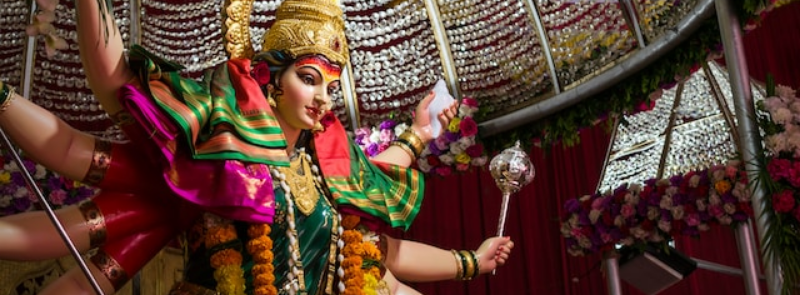
When It Occurs
Annually First Day of Lunar Month Ashwin
Timeline
Days Passed (765)
# Hashtags
#SharadNavratri #DurgaPuja
Sharad Navratri commences on the initial day of the lunar month Ashwin and concludes on the tenth day of the same month. This festival venerates Maa Durga and is observed with profound devotion. Popularly known as Durga Puja, it is predominantly celebrated in Northern and Eastern India.
In Hindu mythology, Lord Ram fervently worshipped the sacred goddess to engage in combat and vanquish the Demon King Lord Raavan. This tale symbolizes the triumph of good over evil.
Significance of Sharad Navratri
- Navratri translates to "nine nights" and is a period dedicated to the worship of Goddess Durga, who symbolizes strength, protection, and the destruction of evil.
- Each of the nine days is devoted to a different form of Goddess Durga, including Shailaputri, Brahmacharini, Chandraghanta, Kushmanda, Skandamata, Katyayani, Kalaratri, Mahagauri, and Siddhidatri.
- Sharad Navratri celebrates the triumph of good over evil, particularly commemorating Goddess Durga’s victory over the demon Mahishasura.
First Day of Sharad Navratri: Kalash Sthapana (Ghatasthapana)
The first day of Sharad Navratri is highly auspicious and involves a ceremonial ritual called Kalash Sthapana or Ghatasthapana, which symbolizes the invocation of Goddess Durga's presence.
Key Rituals and Customs
-
Kalash Sthapana:
- The Kalash (sacred pot) is filled with holy water, covered with mango leaves, and a coconut is placed on top of it. The Kalash represents the Goddess herself, and its establishment marks the start of Navratri rituals.
- The Kalash is often placed on a bed of soil or grains to signify prosperity.
-
Worship of Goddess Shailaputri:
- On the first day, Goddess Shailaputri (the daughter of the Himalayas) is worshipped. She is a manifestation of Parvati, who symbolizes strength and devotion.
- Devotees offer red flowers, milk, and sweets to the goddess and seek her blessings for health, strength, and prosperity.
-
Fasting:
- Many devotees observe fasts during Navratri, starting from the first day. Fasting is seen as a form of purification and devotion. People typically consume only fruits, milk, and specific vrat-friendly (fasting) foods.
-
Chanting and Prayers:
- Devotees recite prayers and hymns, including the Durga Saptashati, a sacred text recounting the deeds of Goddess Durga. The Devi Mahatmya or the "Glory of the Goddess" is also chanted.
- Temples dedicated to Maa Durga are decorated, and special pujas and bhajans (devotional songs) are performed throughout the day.
-
Garba and Dandiya:
- In regions like Gujarat and Maharashtra, people celebrate the festival with Garba and Dandiya Raas, traditional folk dances performed in honor of the goddess. The first day usually sets the tone for these cultural festivities that continue over the nine days.
-
Setting the Stage for Navratri:
- Devotees clean their homes and decorate puja spaces with flowers, diyas (lamps), and rangoli. These preparations are intended to welcome the divine energies and ensure a prosperous and auspicious Navratri.
Spiritual Importance
- The first day of Navratri holds immense spiritual significance as it is believed to be a time when divine energies descend to Earth, offering devotees an opportunity to connect deeply with the goddess's blessings.
- It marks the beginning of a period of inner reflection, purification, and the seeking of spiritual strength to overcome life’s challenges.
- The worship of Shailaputri symbolizes the beginning of the spiritual journey of the devotee, as Shailaputri is associated with the Muladhara chakra, or root energy center in yogic traditions.
Regional Variations in Celebration
- In West Bengal, Navratri coincides with Durga Puja, with elaborate pandals (temporary stages) and larger-than-life idols of Goddess Durga installed for public worship.
- In North India, particularly in states like Uttar Pradesh and Bihar, Navratri is followed by the grand celebration of Ramlila (dramatization of Lord Ram's life), leading up to Dussehra.
- In Gujarat, Navratri is synonymous with Garba nights and Dandiya Raas, which are performed in large community gatherings with traditional music and colorful attire.
Conclusion
The First Day of Sharad Navratri is a time for devotion, rituals, and spiritual awakening. It initiates nine days of celebration that honor the goddess in her various forms, symbolizing different aspects of feminine power. This day, with its rituals of Kalash Sthapana and the worship of Goddess Shailaputri, marks the beginning of the festival with hope, reverence, and a focus on spiritual and physical well-being.


